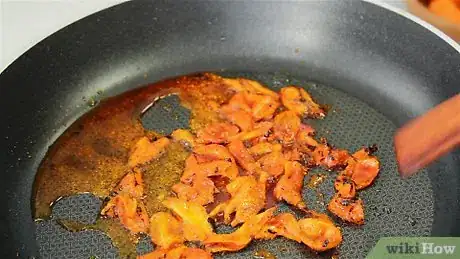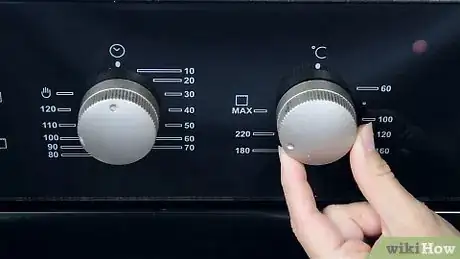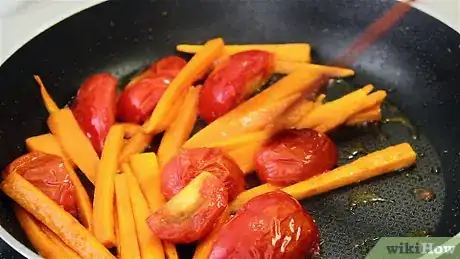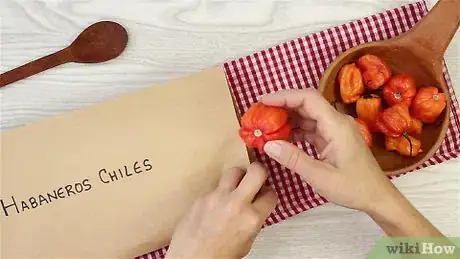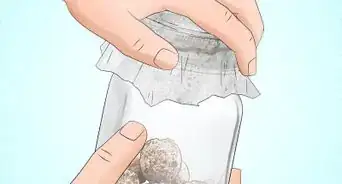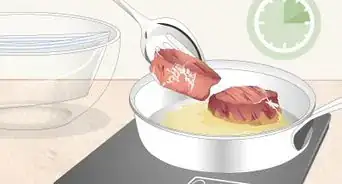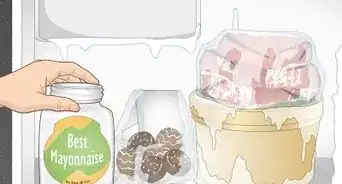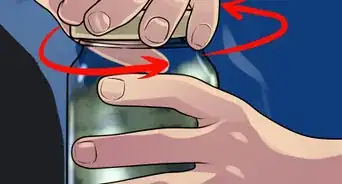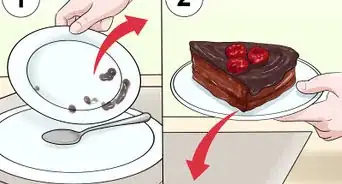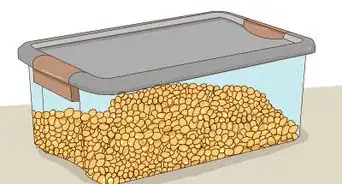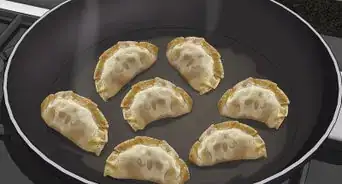This article was co-authored by wikiHow Staff. Our trained team of editors and researchers validate articles for accuracy and comprehensiveness. wikiHow's Content Management Team carefully monitors the work from our editorial staff to ensure that each article is backed by trusted research and meets our high quality standards.
There are 14 references cited in this article, which can be found at the bottom of the page.
The wikiHow Culinary Team also followed the article's instructions and verified that they work.
This article has been viewed 30,131 times.
Learn more...
Habanero peppers pack a huge punch when it comes to spice level! They’re commonly used in hot sauces and Mexican cuisine, and they’re great to add to all kinds of dishes. From roasting to grilling to pureeing into a sauce or oil, there’s really no end to how you can use this tasty, spicy pepper. Soon, you'll be able to drizzle some habanero hot sauce over your eggs in the morning or add roasted habaneros to your next batch of chili.
Ingredients
- 12 habanero chiles, fresh or dried
- 6 peeled cloves of garlic
- 2 peeled and halved onions
- 2 chopped large carrots (optional)
- 2 quartered tomatoes (optional)
- Olive oil
- Salt
- 1 bunch of fresh cilantro
- 1 cup (240 mL) of white wine vinegar
Makes about 4 cups (950 mL) of hot sauce
Steps
Ways to Cook Habaneros
-
1Use a gas stovetop to roast peppers quickly. This also gives the peppers a delicious smoky char. Turn a burner on high and place a pepper right on the flames. Occasionally turn the pepper with a pair of tongs until its entire exterior is black, which will take a few minutes. Repeat with as many peppers as you need. Place the roasted peppers in a bowl and cover the top with plastic wrap or a lid. Once the peppers have cooled down, peel their skins away by hand.[1]
- This method is great when you need to prep just a few peppers for a dish.
- You can use roasted habanero peppers in salsas and hot sauces. You could also add a small amount to pasta or pizza, or toss a few strips onto a sandwich for a spicy addition.
- Keep roasted peppers in your fridge for 5 days or pop them into the freezer for 2 months.
-
2Roast habanero peppers on the grill for a charred flavor. Set your grill to high and place your habanero peppers directly over the flames. Let the peppers roast for about 10 minutes, turning them every 2-3 minutes. To remove the skins, let the peppers steam in a covered bowl until they cool down, then peel the skins away.[2]
- This method works great if you don’t have a gas stovetop or if you need to prep a whole batch of habaneros at once.
- These peppers will last for about 5 days in the fridge or up to 2 months in the freezer.
Advertisement -
3Soften habanero peppers by sautéing them over medium-high heat. Heat some oil on the skillet, then add de-seeded and sliced habanero peppers. Cook the peppers for about 3-5 minutes, or until they start to soften visibly. Add seasonings, like chile powder, cumin, or paprika if you want to.[3]
- Sautéed habaneros go great in fajitas, tacos, or quesadillas. You could also add them to chili, soup, or other dishes that need some spice.
-
4Make a hot chile oil to drizzle on dishes for extra spice. Remove the stems from 8 habanero peppers. Broil the peppers on a baking sheet lined with aluminum foil for 4-6 minutes, turning the peppers every 2 minutes until the skins are blackened. Pop the peppers into a blender along with 1⁄2 cup (120 mL) of olive oil and blend until they reach a smooth consistency.[4]
- Keep the oil covered in the fridge for up to 1 week.
Habanero Hot Sauce
-
1Toast and soak 12 dried habanero peppers to bring out their flavor. If you’re using fresh habaneros, you can skip this step. Toss the dried habanero peppers in a dry skillet for a few minutes, until you smell their aroma. Then, rehydrate the peppers by soaking them in a bowl of hot water for 15 minutes.
- The consistency of dried peppers wouldn’t work well in a pureed hot sauce, which is why it’s important to soak them before adding them to your recipe.
-
2Preheat your oven to 400 °F (204 °C). It’ll take your oven a few minutes to warm up, which is perfect. You can use that time to prep the rest of your ingredients.[5]
-
3De-seed your 12 habanero peppers to cut down on the heat. Do this for both dried and fresh peppers. Most of the habanero’s heat is in the white pith and seeds, so removing them makes your peppers much more palatable (don’t worry—they’ll still be plenty hot!). Slice the peppers open and use a sharp knife to cut away the white membranes and seeds.[6]
- Always wear gloves when working with habanero peppers. Otherwise, you might get hot oil on your hands or face, which would be super painful.
-
4Prep 6 garlic cloves, 2 onions, 2 tomatoes, and 2 large carrots. Peel the garlic and onions, discard the skins, and then chop the onions in half with a sharp knife. If you’re using tomatoes and carrots to add a little more sweetness to your hot sauce, go ahead and quarter the tomatoes and chop the carrots into smaller pieces.[7]
- Even though everything will end up going through the food processor at the end, the garlic and onion skins wouldn’t puree well and would mess up the hot sauce’s texture.
-
5Drizzle the garlic, onions, and fresh habaneros with olive oil. If you’re using dried habanero peppers, leave them out of this step. Spread the veggies out on a baking sheet. Give them a quick drizzle of olive oil.[8]
- Rehydrated habanero peppers can go straight into the food processor because they’re already softened. Fresh habaneros need time in the oven, so their flesh starts to break down, making them easier to puree.
-
6Roast the fresh habanero peppers, garlic, and onions for 30 minutes. Pop the baking sheet into the oven and set a timer. Use the time to clean up the kitchen or cook your carrots and tomatoes, if you’re using them.[9]
-
7Sauté the carrots and tomatoes to add a sweeter element to your sauce. While the other vegetables are roasting, finish preparing the carrots and tomatoes if you’re using them. Heat a little bit of olive oil in a skillet over medium-high heat. Once the oil is hot, add the 2 quartered tomatoes and 2 chopped carrots, and cook them for 5 minutes. Transfer them to the food processor when they’re done.[10]
- The freshness of these veggies adds a nice depth to your recipe, but you can totally skip this part if you want to.
-
8Puree the vegetables and 1 large bunch of cilantro in a food processor. Carefully transfer the roasted peppers, onions, and garlic to a food processor. Add the carrots and tomatoes, if you're using them. Toss a bunch of cilantro in, put on the lid, and start pureeing. Keep going until the mixture is perfectly smooth.[11]
- You could also add a pinch of cumin or some lime juice for a varied flavor.
- A lot of habanero hot sauces have a little grapefruit juice or orange juice mixed in. Don’t be afraid to get creative and mix brighter and sweeter acids with the heat of the habanero.[12]
-
9Stir in 1 cup (240 mL) of white wine vinegar and season to taste. Now you’re to the fun part! After pouring in the vinegar and giving your hot sauce a few stirs, start tasting it. Add salt if it needs it, then taste again. Continue mixing, testing, and adjusting, until the hot sauce is to your liking.[13]
- In addition to adjusting the salt level, you could also add lime juice, more vinegar, or other spices to the mix.
-
10Add 1 tablespoon (15 mL) of water at a time to the hot sauce if it’s too thick. Hot sauce should drizzle off a spoon, thinner than a creamed soup but thicker than broth. If your hot sauce wouldn’t easily pour out of a jar, add water until it gets to the right consistency.[14]
- Wait and do this step last since your sauce should thin out from the addition of the white wine vinegar.
-
11Refrigerate your hot sauce in an airtight container for 2-3 months. Put the sauce into a clean container and secure the lid tightly. Place it in the fridge and label it with the “date made.” Try to use it within a few months for the best taste.[15]
- Get rid of your hot sauce if you see any mold or if it starts to smell strange.
Prep, Safety, and Storage
-
1Wear gloves to protect your hands from burns and irritation. It doesn’t matter how much you love hot peppers, chances are they’re not going to love you back. Keep the pain-causing oils off your hands by wearing gloves, and never touch your face until after you’ve removed the gloves and thoroughly washed your hands.[16]
- Hot peppers, like habaneros, have a lot of capsaicin. Capsaicin is what makes the peppers hot, but it can also get on your hands, in the air, and anywhere you touch.[17]
-
2Remove the seeds and white membranes to reduce the heat level. Peppers hold their heat in the seeds and the white membranes you see when you cut them open. In general, it’s a smart idea to remove these parts whenever you cook with habaneros.[18]
- The white membrane is also referred to as the pith. It’s what holds all those hot little seeds in place.
-
3Use a small amount of habanero and add more if needed. Remember, you can always add more heat, but it’s tough to take it away. Test your dish and add more habanero if you can stand a little more heat.[19]
- If you cut up more habaneros than you end up using, pop the leftovers into an airtight container and keep them in the fridge. Use them within a week.[20]
-
4Cool habanero burns with milk. You can drink milk or even put it on your skin to reduce pain from any kind of hot pepper, including habaneros. Since the heat from the habanero comes from oil, drinking water will just spread the heat around. Milk will actually break it down.[21]
- You could also use lemon juice for burns on your skin.[22]
-
5Keep fresh habanero peppers in the fridge for up to 1 week. Help them last as long as possible by putting them into a paper bag and storing them in the crisper section of your fridge.[23]
- Label the date or put a reminder in your phone, so you use them or transfer them to the freezer in time.
-
6Slice and freeze habanero peppers for up to 12 months. Slice and de-seed any peppers you can’t use before they start to go bad. Put the peppers into a freezer-safe container or bag, and pop them into the freezer.[24]
- The peppers will still be safe to use after 1 year; they’ll just taste the best the sooner you use them.
-
7Store dried habaneros in an airtight container for 3-6 months. The peppers will last longer than that, but they’ll taste the best if you use them within 6 months of putting them into storage. Put the airtight container either into the fridge or the freezer, whichever you prefer.[25]
- Dried habaneros are a great option to keep around if you don’t always have access to fresh hot peppers.
Warnings
Things You’ll Need
Habanero Hot Sauce
- Skillet
- Bowl
- Knife
- Cutting board
- Gloves
- Baking sheet
- Oven mitt
- Food processor
- Airtight container
References
- ↑ https://www.thekitchn.com/how-to-roast-peppers-3-ways-234734
- ↑ https://www.thekitchn.com/how-to-roast-peppers-3-ways-234734
- ↑ https://www.foodandwine.com/recipes/hot-habanero-chicken-fajitas
- ↑ https://www.tastingtable.com/cook/recipes/octopus-salad-recipe-habanero-enrique-olvera
- ↑ https://www.foodnetwork.com/recipes/home-style-habanero-hot-sauce-2106622
- ↑ https://www.foodnetwork.com/recipes/habanero-salsa-recipe-1940155
- ↑ https://www.foodnetwork.com/recipes/home-style-habanero-hot-sauce-2106622
- ↑ https://www.foodnetwork.com/recipes/home-style-habanero-hot-sauce-2106622
- ↑ https://www.foodnetwork.com/recipes/home-style-habanero-hot-sauce-2106622
- ↑ https://www.seriouseats.com/recipes/2009/08/serious-salsa-habanero-hot-sauce-spicy-recipe.html
- ↑ https://www.foodnetwork.com/recipes/home-style-habanero-hot-sauce-2106622
- ↑ https://www.seriouseats.com/recipes/2016/05/extra-hot-yucatan-style-salsa-recipe.html
- ↑ https://www.foodnetwork.com/recipes/home-style-habanero-hot-sauce-2106622
- ↑ https://www.seriouseats.com/recipes/2009/08/serious-salsa-habanero-hot-sauce-spicy-recipe.html
- ↑ https://www.canitgobad.net/can-hot-sauce-go-bad/
- ↑ https://www.thekitchn.com/the-best-remedies-for-hot-pepper-hands-tips-from-the-kitchn-208527
- ↑ https://www.southernliving.com/veggies/peppers/habanero-pepper-recipes
- ↑ https://www.southernliving.com/veggies/peppers/habanero-pepper-recipes
- ↑ https://www.masterclass.com/articles/how-to-use-habanero-peppers-in-your-cooking#5-tips-for-cooking-with-habanero-peppers
- ↑ https://www.stilltasty.com/fooditems/index/17368
- ↑ https://www.southernliving.com/veggies/peppers/habanero-pepper-recipes
- ↑ https://www.masterclass.com/articles/how-to-use-habanero-peppers-in-your-cooking#5-tips-for-cooking-with-habanero-peppers
- ↑ https://www.stilltasty.com/fooditems/index/17368
- ↑ https://www.stilltasty.com/fooditems/index/17368
- ↑ https://www.epicurious.com/ingredients/types-of-dried-chiles-how-to-buy-and-store-article
- ↑ https://www.epicurious.com/ingredients/types-of-dried-chiles-how-to-buy-and-store-article
- ↑ https://www.thekitchn.com/how-can-i-prevent-fumes-when-cooking-chiles-229857
- ↑ https://www.thekitchn.com/the-best-remedies-for-hot-pepper-hands-tips-from-the-kitchn-208527
- ↑ https://www.stilltasty.com/fooditems/index/17368

